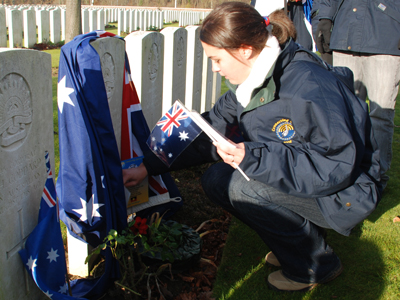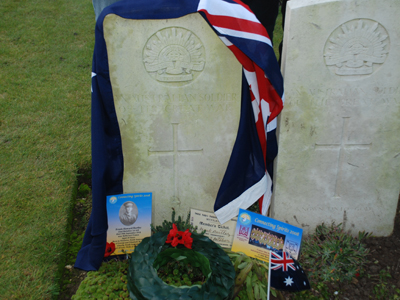Dec 2
Tuesday December 2: Amiens
Today, after a commemoration at Longueau Communal Cemetery, we had our major commemorative service at Villers-Bretonneux honouring 18 soldiers. The ceremony was simple yet incredibly moving. We started with a brief outline of the significance of the Australian National memorial. This is a beautifully designed structure. White and dominant it stands on the top of the hill overlooking the Somme Valley. Gathered under the main tower, each of the 18 soldiers’ stories were delivered with sincerity and feeling. Each person gave an individual dedication to their soldier and then the most perfect experience of any of the commemorative trips I have organised, occurred. Over the last two years since the 2006 trip, Flo Bourke and Rita Lindsay have been writing their own songs focusing on their personal experiences during the Connecting Spirits journey. Their songs focus on a range of aspects and feelings associated with their interpretations of the WW1 story. Both girls have performed their music to public audiences both large and small over the last year and the reactions have been very appreciative the most memorable coming from a Vietnam veteran who was speechless after Flo sang “Commemoration Story”. He was meant to give a vote of thanks after a presentation we gave. He could not speak and with tears streaming down his face he just hugged Flo. Later after gaining his composure he softly said to the pair of us, “You don’t know much this means to a veteran like me. The fact that young ones care about these men and those who followed like my Vietnam mates is very important to us.” This song was the one she sang today in front of the very memorial its lyrics were about.
“Commemoration Story” was written after Flo participated in the 2006 Villers-Bretonneux ceremony. The song tells of the 11,000 Australian names of soldiers missing on the Western Front with no known grave. She wrote of how as a young person these names opened a new chapter in her life and made a personal promise to never forget them. Names on the white walls told their own sad accounts of lives lost. So after hearing this song performed in halls, at Lions and Rotary dinners and other venues here we were and Flo was back at the site of her creative inspiration. She stepped up to the steps and sat in the middle of four kids who were holding the two flags side by side, the Australian and Ngarrindjeri creating a framework. Flo sat down on the step and as she sang the words I’d heard many times, the atmosphere she created was electric. Tears falling, she never missed a beat and as she sang she looked over the Somme battlefields and occasionally up to the names she was dedicating. Tristan one of the flag holders struggled to keep his composure, his face moving and looking upwards. His sadness was clear. Other kids cried, their heads down caught up in their own private thoughts. What a moment. As I type these words sitting in the hotel at Amiens and Mal is flicking through the photos to select images, I am transported back to that place. As a teacher I have been a part of many wonderful encounters with kids particularly on these trips and I can honestly say today was right up there for me. Later I would say to Flo that she must never forget what happened at Villers-Bretonnuex memorial on December 2nd 2008. The impact on all who were there was profound. When we are able to professionally record hers and Rita’s music next year when the group listens to “Commemoration Story” this special day will return in their memory. Watching this young woman only 19 years of age having such grace, dignity and composure to perform under such demanding emotional conditions was very poignant. Suzanne and John your daughter is one very special person. If only you could have shared that moment with your beautiful young girl. The reflections of those present follow:
CHLOE PADMAN:
Today was really special seeing 11,000 names written all over these massive walls. It was upsetting to think that all of those names, ALL of them are still out in the fields somewhere buried or just blown up. Seeing 20 soldiers commemorated all at once told the story.
NICOLE WEIDENHOFER:
Today I commemorated my great, great Uncle George Harold Weidenhofer. It was the hardest, saddest yet the best thing I have ever done. I read a poem chosen by my grandpa. I felt privileged to be the one to stand up and tell his story on behalf of the Weidenhofer family. It is something I will take with me for the rest of my life.
BETHANY JURGS:
Today was heaps different to yesterday’s commemorations because there were lots of people’s soldiers all at once. This made it more real that there WERE lots of soldiers killed. I became emotional again and teary but also proud of our group.
JAMES GEORGIOU:
The visit to Villers-Bretonneux memorial was one of the most moving days of my life. I commemorated Stanley James Carraill. This time Flo’s song really hit me. It was a great day.
PAUL SINKINSON:
Today when Flo played her song the words meant something to me for the first time. Her lyrics and music drifted and echoed around the memorial filing the air with warmth.
HAMISH JURGS:
When we arrived at the memorial it was dark and very cold. By the end of the service the sun was shining brightly on us. It was very emotional and lots of tears were shed.
MICHELLE CROSSMAN:
It was a great honour to play the “Last Post” at our memorial at Villers-Bretonneux. It touched my heart deeply.
BELINDA KOOLMATRIE:
Today we commemorated two Ngarrindjeri soldiers Arthur Thomas walker and Francis Alban Varcoe. Words can not explain the feelings and thoughts we experienced as we paid tribute, respect and honour to these men. We felt proud as Ngarrindjeri women to have the privilege to travel to France to remember the 21 Ngarrindjeri soldiers who fought and five who died for our people, our country and for all Australians. We achieved a memorable commemoration with respects to the soldiers’ families.
‘Ngarrindjeri warrior we’ve come to take your spirit home.’ (quoted from ‘Lost Soul’ by Eric Bogle)
Rest in peace…..Lest we forget.
HAYDEN BIDDLE:
Villers-Bretonneux ceremony was very moving especially Flo’s song. Seeing all the names on the wall while Flo was singing made me shed a tear. I commemorated Arthur Hamlyn and felt sad that his body was never recovered. I will never forget today.
KATE FORD:
Today I commemorated David Forrest on behalf of Brian and Jan James at Villers- Bretonneux. The memorial was extremely moving and emotional. Australia is so present here. I felt closer to home.
JAMES FERGUSON:
Today when I did my first commemorations the feeling of honour and mixed emotions was incredible. When you learn about the numbers of casualties and see the battlefields words are hard to find to explain one’s feelings. God bless all of the families who lost loved ones. Today I felt a little of your sadness.
EMILY COCK:
We commemorate the fallen and remember the brave but can words ever really represent the feeling deep inside your stomach when you see their names and acknowledge that these men were real and they died for you?
As these reflections show the time at VB was one never to forget. However this was just the start of a very big day. Other soldiers in other cemeteries awaited and as we walked away from the memorial our thoughts started to move elsewhere.
We then commemorated another soldier in the Villers-Brettoneux Military Cemetery which is in front of the memorial. From here we drove to the other side of Villers-Bretonneux to the Crucifix Corner Cemetery for 2 more commemorations. After a quick lunch in a truck stop nearby we headed east along the old Roman road that links Amiens with St Quentin to Heath Cemetery where we commemorated another 5 soldiers. The numbers of medal winners in this place was quite extraordinary. We had three indigenous men here; Thomas James Walker, Reg Rawlings (MM) and Harry Thorpe (MM).
Then a fairly long drive to the Peronne Community Cemetery Extension for 2 more commemorations before again taking to the road to Bellicourt. Here we commemorated another soldier before the Jurgs family made a tribute to Frank Bartley at a grave of an unknown soldier that they have adopted as Frank's. While in Bellicourt we walked down to where the St Quentin Canal enters a tunnel which takes it under the town for 5 kms. This tunnel was dug in 1802 by political prisoners of Napoleon. When you consider the lack of technology available it was a remarkable feat. The Germans used this tunnel as a large dugout during the final stages of the war.
The end of the day saw the mood change with lots of out of tune singing by the gang and the start of an emotional debrief needed for such a charged day. Tuesday December 2, 2008 will be in my memory for a long time.
BETHANY JURGS:
Today was the most emotional day I have ever experienced. I commemorated three soldiers including my great, great uncle Frank with Hamish. It went well until I came to his adopted grave and I couldn’t hold back the tears. It was the most wonderful and sad thing I have ever done.













































